Related Research Articles

The lobopodians, members of the informal group Lobopodia, or the formally erected phylum Lobopoda Cavalier-Smith (1998), are panarthropods with stubby legs called lobopods, a term which may also be used as a common name of this group as well. While the definition of lobopodians may differ between literatures, it usually refers to a group of soft-bodied, worm-like fossil panarthropods such as Aysheaia and Hallucigenia.

In genetics, an enhancer is a short region of DNA that can be bound by proteins (activators) to increase the likelihood that transcription of a particular gene will occur. These proteins are usually referred to as transcription factors. Enhancers are cis-acting. They can be located up to 1 Mbp away from the gene, upstream or downstream from the start site. There are hundreds of thousands of enhancers in the human genome. They are found in both prokaryotes and eukaryotes.

Zinc finger protein GLI3 is a protein that in humans is encoded by the GLI3 gene.
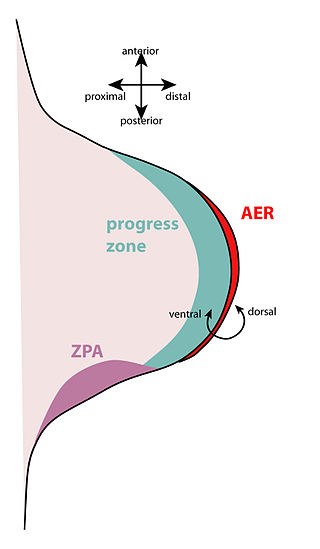
The apical ectodermal ridge (AER) is a structure that forms from the ectodermal cells at the distal end of each limb bud and acts as a major signaling center to ensure proper development of a limb. After the limb bud induces AER formation, the AER and limb mesenchyme—including the zone of polarizing activity (ZPA)—continue to communicate with each other to direct further limb development.
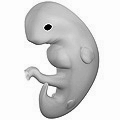
Limb development in vertebrates is an area of active research in both developmental and evolutionary biology, with much of the latter work focused on the transition from fin to limb.
The limb bud is a structure formed early in vertebrate limb development. As a result of interactions between the ectoderm and underlying mesoderm, formation occurs roughly around the fourth week of development. In the development of the human embryo the upper limb bud appears in the third week and the lower limb bud appears four days later.
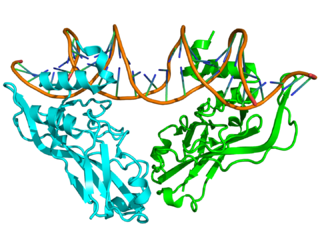
T-box refers to a group of transcription factors involved in embryonic limb and heart development. Every T-box protein has a relatively large DNA-binding domain, generally comprising about a third of the entire protein that is both necessary and sufficient for sequence-specific DNA binding. All members of the T-box gene family bind to the "T-box", a DNA consensus sequence of TCACACCT.

The (pan)arthropod head problem is a long-standing zoological dispute concerning the segmental composition of the heads of the various arthropod groups, and how they are evolutionarily related to each other. While the dispute has historically centered on the exact make-up of the insect head, it has been widened to include other living arthropods such as chelicerates, myriapods, crustaceans; and fossil forms, such as the many arthropods known from exceptionally preserved Cambrian faunas. While the topic has classically been based on insect embryology, in recent years a great deal of developmental molecular data has become available. Dozens of more or less distinct solutions to the problem, dating back to at least 1897, have been published, including several in the 2000s.
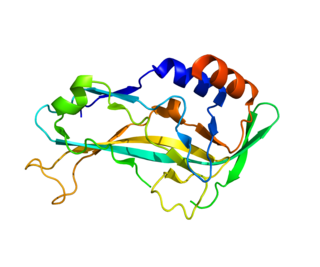
T-box transcription factor TBX5, is a protein that in humans is encoded by the TBX5 gene.

Fibroblast growth factor 8(FGF-8) is a protein that in humans is encoded by the FGF8 gene.

Homeobox protein Hox-D13 is a protein that in humans is encoded by the HOXD13 gene. This gene belongs to the homeobox family of genes. The homeobox genes encode a highly conserved family of transcription factors that play an important role in morphogenesis in all multicellular organisms.

Fibroblast growth factor 4 is a protein that in humans is encoded by the FGF4 gene.
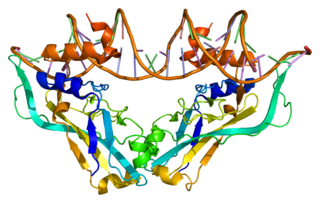
T-box transcription factor 2 Tbx2 is a transcription factor that is encoded by the Tbx2 gene on chromosome 17q21-22 in humans. This gene is a member of a phylogenetically conserved family of genes that share a common DNA-binding domain, the T-box. Tbx2 and Tbx3 are the only T-box transcription factors that act as transcriptional repressors rather than transcriptional activators, and are closely related in terms of development and tumorigenesis. This gene plays a significant role in embryonic and fetal development through control of gene expression, and also has implications in various cancers. Tbx2 is associated with numerous signaling pathways, BMP, TGFβ, Wnt, and FGF, which allow for patterning and proliferation during organogenesis in fetal development.

Homeobox protein engrailed-1 is a protein that in humans is encoded by the EN1 gene.

Protein odd-skipped-related 1 is a transcription factor that in humans is encoded by the OSR1 gene. The OSR1 and OSR2 transcription factors participate in the normal development of body parts such as the kidney.
Cheryll Anne Tickle is a distinguished British scientist, known for her work in developmental biology and specifically for her research into the process by which vertebrate limbs develop ab ovo. She is an Emeritus Professor at the University of Bath.

The zone of polarizing activity (ZPA) is an area of mesenchyme that contains signals which instruct the developing limb bud to form along the anterior/posterior axis. Limb bud is undifferentiated mesenchyme enclosed by an ectoderm covering. Eventually, the limb bud develops into bones, tendons, muscles and joints. Limb bud development relies not only on the ZPA, but also many different genes, signals, and a unique region of ectoderm called the apical ectodermal ridge (AER). Research by Saunders and Gasseling in 1948 identified the AER and its subsequent involvement in proximal distal outgrowth. Twenty years later, the same group did transplantation studies in chick limb bud and identified the ZPA. It wasn't until 1993 that Todt and Fallon showed that the AER and ZPA are dependent on each other.
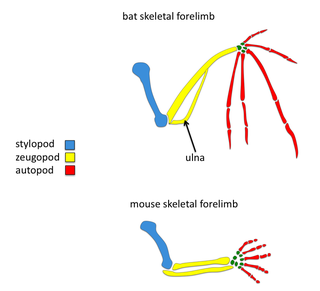
The order Chiroptera, comprising all bats, has evolved the unique mammalian adaptation of flight. Bat wings are modified tetrapod forelimbs. Because bats are mammals, the skeletal structures in their wings are morphologically homologous to the skeletal components found in other tetrapod forelimbs. Through adaptive evolution these structures in bats have undergone many morphological changes, such as webbed digits, elongation of the forelimb, and reduction in bone thickness. Recently, there have been comparative studies of mouse and bat forelimb development to understand the genetic basis of morphological evolution. Consequently, the bat wing is a valuable evo-devo model for studying the evolution of vertebrate limb diversity.

Transcription factor Sp8 also known as specificity protein 8 (SP-8) or Btd transcription factor (buttonhead) is a protein that in humans is encoded by the SP8 gene. Sp8 is a transcription factor in the Sp/KLF family.

Clifford James Tabin is chairman of the Department of Genetics at Harvard Medical School.
References
- ↑ "Interactive Fly, Drosophila".
- ↑ Moczek, A. P.; Rose, D. J. (2009). "Differential recruitment of limb patterning genes during development and diversification of beetle horns". Proceedings of the National Academy of Sciences. 106 (22): 8992–7. doi: 10.1073/pnas.0809668106 . PMC 2690047 . PMID 19451631.
- ↑ Janssen, R.; Eriksson, B. J.; Budd, G. E.; Akam, M.; Prpic, N. M. (2010). "Gene expression patterns in an onychophoran reveal that regionalization predates limb segmentation in pan-arthropods". Evolution & Development. 12 (4): 363–72. doi:10.1111/j.1525-142X.2010.00423.x. PMID 20618432. S2CID 27770103.